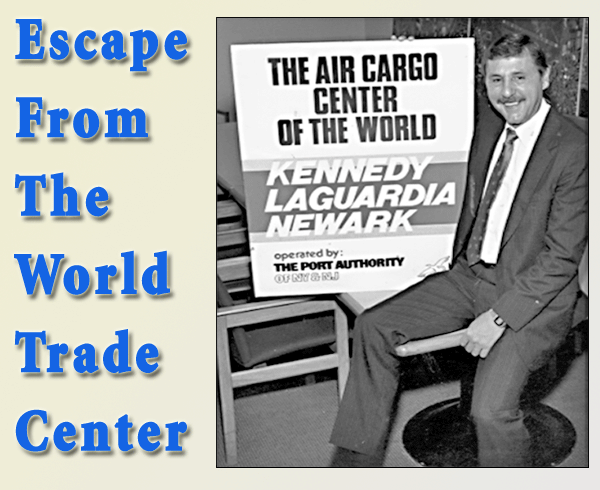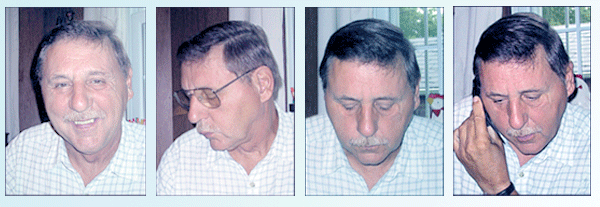Escape
From The World Trade Center Chapter 23
Americans old enough to remember watched
in horror as the terrorist attacks of September 11, 2001 left nearly 3,000
people dead in New York City, Washington, D.C., and Shanksville, Pennsylvania.
Now as we recall that sad day, 23 years
later, pleased to report that Jim Larsen, 2001 Air Cargo Manager at The
Port Authority of New York & New Jersey, who was sitting in his office
on the 65th floor of Tower One in The World Trade Center when the planes
struck, lived to tell his story about the experience in detail.
You can say life brings strange tales or
even if you believe that there are no coincidences, this gentle man who
walked through the gates of hell on 9/11 and lived to tell about it, went
on in retirement to move to Lakehurst, New Jersey, near where the most
famous air disaster in history before 911 occurred, the much reported
May 2, 1937 explosion that took down the mighty German Airship Hindenburg.
Two days after the 9/11 tragedy, Jim walked
into our home near JFK International Airport with a manuscript in hand
documenting minute-by-minute his “Escape From World Trade Center
On 9/11” that we have published every year on that date and respectfully
present here for the 23rd time.
When I asked him where he was going September
13, 2001, recall he said quietly “to JFK Hangar 14 and 17 where
they have set up a contact spot for people to get in touch.
“I want to find out if anyone else
got out alive,” Jim Larsen said.
Some time later Jim would travel back to
the World Trade Memorial Site in Manhattan where he would perform as a
tour guide sharing his story of that day as an eyewitness from the inside
out of the catastrophe and its aftermath with tens of thousands of people
that flocked to the site from the U.S. and around the world.
Now over two decades later, others who lived
during that time can never forget it.
We were inside the World Trade Center visiting
Jim in his office just the day before 9/11 on 9/10, the day I turned 60.
Had departed our home in Queens, New York
and were out on a beautiful early Autumn drive around Manhattan Island
that featured a special birthday luncheon at Café Des Artists.
Always with some business to attend to,
Sabiha was delivering the September issue of Air Cargo News FlyingTypers,
our print publication to the aviation department, while I waited by our
Vanagon, looking up at the twin towers, at a sight that less than 24 hours
later would come crashing down for all time.
Today Jim is still in Lakehurst, actively
writing often about his life and times in air cargo at Seaboard World
Airlines.
Here once again we present with love and
affection and no small amount of continued longing and sorrow: Jim
Larsen's story, "Escape
From The World Trade Center."
GDA
 |
The morning
of September 11th could best be described as ideal. The sun was bright,
the air was clear, and from the 65th floor of the World Trade Center I
could look across, through New Jersey, almost to the Poconos in Pennsylvania.
Just a few odds and ends to take care of and I would be on my way to JFK
for a luncheon hosted by a cargo promotion group from the U.K.
The office was quiet, waiting for the aviation
department staff to filter in for the start of another day. Just another
ordinary day. I was sitting at my computer and chuckling about a joke
that someone had sent me via e-mail when it hit. It wasn’t loud;
there was no explosion, no thunder, just a kind of whack. Then the building
began to lean over. Things fell off the desk, furniture moved, and I made
my peace with God convinced that the tower was about to topple. But miraculously
it didn’t. It snapped back and slowly went the other way. Like in
an earthquake, the building continued to shudder for what seemed a lifetime,
but what in reality was most likely just a few seconds. There was a brief
silence as debris started to stream past the windows, falling to the street
below. An aircraft, I thought? But how could an aircraft collide with
the building on such a clear day? No time to ponder that question, I thought,
let’s get out of the building. I looked for people on my side of
the building and saw no one, so I took off for the fire exit and the staircase
that would lead me out of the building. Two women came out of the south
side of the floor crying. I ordered them not to use the elevators. “Head
for the stairs,” I said, “Everything is OK. The building is
still standing so the worst is over. Take your time, it’s OK, we’re
safe now.” At that point I honestly believed that was true. I also
think that all the people in the stairwell thought the same thing. There
was no panic, no screaming, no shouting. Everyone proceeded in an orderly
manner; they kept talking to each other, they helped those who were having
difficulty breathing because of the smoke, or difficulty walking for whatever
reason. It was a slow walk down. We stopped every once in a while because
of unknown delays below us, but all in all, the pace was fairly steady.
As we got further and further down, I think
we all knew that at any moment we would see rescue workers coming up the
stairs. On the 27th floor landing we came upon a man in a wheelchair.
On each side of him stood his coworkers, who were apparently waiting for
the crowd to thin out so they could begin moving him down the staircase.
We passed him, and I thought for a moment maybe we should try in some
way to take him with us, but it still seemed like there was no immediate
danger and that it would be best if he waited there until help arrived.
I don’t know if that man and his loyal friends got out; I can only
pray that they did.
At one point while we were descending I
thought I was succumbing to the smoke in the stairwell. I began to get
unsteady on my feet; it was almost as if the building was swaying again
but I dismissed the thought and shortly afterward I felt OK again. It
wasn’t until the next day that I realized it was the impact of the
aircraft hitting Tower Two that had made me feel that unsteadiness. Soon
we came to a point at which we felt fresh air coming up from somewhere
below us. Fresh air was only a few flights away. Firemen and policemen
passed us and went up the stairs. Everyone was telling them about the
man in the wheelchair on 27. When we got to the mezzanine floor rescue
workers were shouting at us to move quickly. Why all the urgency, I thought.
They seemed more panicky than we were. It’s all over, we are safe
now, why are you shouting? Then the first in a series of realities set
in. As we moved from the exit on the West side of the mezzanine to the
escalators on the East side of the building we looked out on to West street
and saw the tremendous amount of debris at the West Street entrance to
the building. Glass was everywhere and I thought if anyone was out there
they were probably dead or seriously wounded. We turned and headed East
toward the escalators that led to the shopping concourse one floor below.
At that point we stepped into Hades: rescue workers were shouting and
urging us on; there was complete and utter chaos. We got our first look
at hell. The glass partitions looking out over the WTC plaza were bloodstained,
parts of bodies and what appeared to be wreckage from the aircraft littered
the entire plaza. The debris was so deep that the concrete surface of
the plaza was not visible anywhere. Still, harsh reality had not completely
sunk in. It was more like we were all watching a disaster movie, like
we were just observers. There was more shouting and more urgent calls
to keep moving. We went down the escalator steps, through the shopping
concourse and out on to Church Street.
 |
Being on the street was like coming to dry
land after an ocean voyage; you almost felt like you wanted to kiss the
ground. There was no time to stop, rescue workers continued to urge us
on up Fulton Street toward Broadway. As we crossed Church Street we finally
had a chance to look back and actually see the towers. At that point the
adrenaline kicked in. The buildings were on fire; they looked like two
candles standing in the sun. We began to head North on Broadway. I stopped
to talk to the wife of a co-worker. She also worked in Tower One and was
searching the crowd for her husband, to no avail. “Did you see him?”
she asked.
“No, but I’m sure he’s
OK,” I said, “We had plenty of time to get out, he will be
all right.” We continued North up Broadway, funny enough, I was
looking for a cigar store. I haven’t smoked in a while but I had
an overwhelming urge to have a cigar. For a moment the urge took my mind
off what was happening and I was preoccupied with finding a cigar. We
had planned to go to the City Hall subway station to get a train uptown
but when we got to the station we were told there was no train service.
They said we should go to 14th street, trains would be running from there.
I was with two co-workers and both were not doing too well. One has a
severe back problem and the other had forgotten her knee brace and was
starting to feel the effects of our walk.
We turned to look back at the towers just
as Tower Two collapsed. It was amazing. This giant structure that we had
come to regard as a fixture in our every day lives crumbled before our
eyes, creating a giant dust cloud reminiscent of the films we saw of the
eruption of Mt. St Helens. Panic filled the streets as the clouds advanced
up Broadway. In front of it hundreds of people were screaming and running
toward us. The only thing I could think to do was get the two girls out
of the way of the crowd.
“We can’t get hit with any debris;
the worst we will feel is dust. But if we stay out here there is a chance
that we’ll get trampled by the crowd.” I pushed them up against
the fence at City Hall as we watched the dust cloud advancing. Miraculously
it stopped about a hundred feet from where we were standing and lost momentum,
settling to the ground.
Safe again and blocks away, I looked back
at Tower One. It was burning and there was no doubt that it was only a
matter of time before it too would collapse. I didn’t know in what
direction it would fall, but between us and the tower is the Woolworth
building so I turn to my brave little group and urge them on North. “Lets
get out of here, if Tower One falls and hits the Woolworth building we
will be in big trouble.” We head for Canal Street with the hopes
of getting a train that will take us away from the nightmare. As we keep
moving, I constantly try to call my wife on a cell phone but I can’t
get through. I want to tell her I’m all right; I also want to find
out if anyone has heard from my son who works in the World Financial Center
directly across the street from the towers. My thoughts go back to the
last bombing of the World Trade Center and the fact that I couldn’t
get in touch with her then either. On that occasion she ended up calling
her niece, a waitress in a restaurant near Wall Street, to tell her that
she didn’t know if I was OK. Her niece’s reply was, “He’s
fine; he’s sitting here at the bar having a Gin and Tonic.”
No such luck this time; I didn’t have a chance to sit with a drink
until 6:00 p.m. that night.
Soon there was a call on my cell phone.
My wife asked if I was OK and told me that my son was on his way home.
He never reached his office, saw the disaster and turned around. Thank
God! Moving North, the fearless crew now numbered five- two going to the
Bronx, one to Long Island, one to New Jersey and myself headed for Westchester.
As we continued it was obvious that the two women with back and leg problems
were not going along too well. The further we got, the slower we moved.
We continued to get glimpses of Tower One in the distance. It was still
standing but we lost sight of it as we passed a fairly tall structure
that obscured our view. Then we see another dust cloud: One World Trade
Center, my home away from home for the past 13 years, is gone. With it
went many, many memories, and many coworkers whose fate at that point
was unknown to me.
On we went uptown, our little crew feeling
more and more the effects of the experience and getting weaker all the
time. Then, lo and behold, a banner stating the home of the Public Theater.
I know someone who works there so I went to the entrance, but I was told
that no one was allowed in. “Is she here?” I asked, and all
of a sudden the way is opened and I’m escorted to her office. There
I talked to the first person I had spoken to all day who was not directly
involved in the disaster. Our crew is brought into the lobby, seated and
served water and soda, and they rest to gather the strength to continue
the journey. An oasis in the middle of Manhattan, I thank you for your
hospitality Public Theater, and thanks to my friend for a hug and an understanding
ear.
Rested and on our way again, the group now
numbered six (my friend joined us). When we reached 14th Street we found
that there was no room at the inn: the subway was closed there too. Next
stop Grand Central. I didn’t think the group was physically able
to make it but we continued on. The next shock! Armed National Guardsmen
were in the streets in front of what I later realized was an armory off
Park Avenue. The realization that the roars we had been hearing in the
sky were not low flying Helicopters but high flying fighters over our
city, over New York, on a defense mission over American soil, was too
much to comprehend.
When I was a little boy during World War
II, I remember air raid wardens knocking on windows at houses that had
lights on. I remember the black window shades that hung in our railroad
flat in Queens for years after the war was over. But that was only a drill,
no one ever got to really attack America.
Sure, there was Pearl Harbor, but that wasn’t
America. That was some island out in the middle of nowhere where our fleet
was. Here, today was reality; a hostile force had made an air strike against
the United States and had successfully destroyed two key locations.
That aside, we were back in business moving
toward our next goal, Grand Central Station. From there we hoped to get
a train that would take the Bronx contingent home and possibly afford
some transportation to Queens for the Long Island bound person in our
group. Unfortunately, the group was running out of steam very quickly;
back pains were becoming worse and the trauma of walking on a bad knee
was obviously getting the best of the women. It was time to get some help.
I walked out into the middle of Park Avenue to a traffic policeman and
explained our problem, asking him if he could flag down anyone who could
take the women to Grand Central. He was sympathetic and tried to flag
down any emergency vehicle heading North, but of course they were on other
missions and couldn’t divert. Finally we asked a gentleman in an
automobile if he would consider taking some passengers for the ride, which
was then about 20 blocks. He said of course, so we piled four of the group
into his car and they departed for Grand Central with the plan that we,
my friend from the Public Theater and I, would meet up at the station
and go from there. Thank you to the gentleman in the car, you were a true
New Yorker, willing to lend a hand when it was needed. I can’t say
the same for the numerous taxicabs that passed us during our journey with
their off duty signs on and their cabs empty.
My friend and I reached Grand Central but
found no trace of the rest of our group (who I later found out had made
it home ok) so when a departure was announced for a train that would take
me home to Peekskill, I opted to get on it, hoping that the rest of my
group also made some sort of connection to their destinations.
Our departure from the city was like leaving
a bad dream behind. It was almost as though it hadn’t happened,
and as our train headed north I felt the comfort of finally resting away
from the terrible events of the day. That feeling overwhelmed me just
before we reached Tarrytown, when as we gazed out the window at the smoke
rising from the Trade Center, we saw a man standing in a small Hudson
River park. The flag in the park was already at half-mast, and the man
was quietly and casually watering the grass, as life went on.
THE AFTERMATH
Arriving at the Peekskill station and into
the arms of my wife was an experience that will live with me forever,
but at that point the realization of just how close I had come to death's
door was not yet real. During the course of the day's events none of us
had actually seen the disaster in total. We hadn’t seen the TV coverage
and heard very little of the radio broadcasts, so the harsh realities
of what had actually transpired were yet to come. But there was another
experience waiting: the immediate love that poured from friends and acquaintances
began. By then I was ready for a good stiff drink and I proceeded to my
favorite watering hole right there in the station. Genuine people, both
casual and close friends, were on hand to greet me and to tell me how
they had feared the worst, and how happy they were that I was there with
them. I told them I was equally as happy to see them.
On the way home, my wife related a list
of calls she had gotten during the course of the day from people in the
air cargo community, both here in New York, and abroad. The list seemed
endless and I felt the camaraderie that we in our business know extends
through all of us when we are in danger or in need. Those communications
continued for the next two days, reaching from coast to coast and across
the world. What a wonderful community we have, what a wonderful group
of rough and ready people make up our cargo group.
As I sat to watch the TV coverage it hit!
People jumping from buildings, people crying, people desperately looking
for their friends and loved ones. The tragedy unfolded before my eyes
and I was overcome with the sights and sounds of that day. The man in
the wheel chair on the 27th floor, so helpless and forlorn. The firemen
and policemen who passed us on the staircase, brave men headed for what
possibly was their demise. I remembered one in particular, a fireman,
quite hefty, loaded down with gear and obviously a little out of shape.
He stopped for a moment on the landing to catch his breath, then continued
on up the staircase. I don’t know if he was ever seen again, but
I hope he made it out.
I remember my annoyance at the shouting
of the rescue workers when we reached the mezzanine and feel guilty for
feeling that way at the time. I now wonder how many of those good, brave,
professional people made it out safely. Prior to this incident I took
all those people for granted and thought, well, that’s their job.
Now I think while we were running away from disaster, they were knowingly
running into it without regard for their own safety. I will never take
those services for granted again and I will never forget that one fireman
on the stairs and the many others who we passed that day.
The recollection of coming down those stairs,
no panic, people giving encouragement and physical help to those who were
faltering, is a strong one. “Its OK, we are going to be all right,”
became standard and was the marching song as we moved closer and closer
to safety. Afterwards I recall thinking New York excelled again, as restaurant
personnel stood on the sidewalks in front of their establishments giving
out bottled water. Some even brought out hoses so that people covered
with ashes could rinse themselves off. “Our restrooms are open to
pregnant women and the elderly,” read a sign in front of one of
the establishments we passed, a small token but a good heart.
As these days have passed I mourn for those
who did not make it: coworkers, friends and associates who lost their
lives in a senseless act of aggression. But on the other hand I fear for
those good people who may be singled out because of their religious beliefs
or because of the country they happened to be born in.
We are good people. Those of us who survived
this disaster have to keep in our hearts the realization that it was not
the fault of an entire religion or an entire race, but the sickness in
the minds of a relatively few individuals whose regard for human life
does not stop with us. Their hatred goes far beyond our borders, and the
people they hurt even number their own countrymen. If we succumb to the
same type of thinking as the religious zealots, then we will never, ever
see peace for ourselves, our children, or their children. I believe that,
for those responsible, justice should be swift and final. But let us concentrate
our hatred on those few, sick minds that are responsible, and on them
only.
Jim Larsen
|





 Vol.
23 No. 33
Vol.
23 No. 33